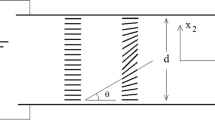Abstract
A micromorphic electroelastic model for polarized liquid crystals is proposed on the basis of a representation of electric multipoles in terms of microdeformation. Nematic liquid crystals are modeled as micropolar continua endowed with intrinsic electric dipole and quadrupole. A nonlinear dimensionless problem for a homogeneous nematic layer is formulated and solved numerically. The existence of a threshold electric potential is discussed, and the corresponding linearized system is also obtained to compare results on small values of deformation and electric field. Differently from common results of the classical continuum approach, asymmetric deformations and electric potentials within the layer are obtained due to the occurrence of non-null intrinsic quadrupole.
Similar content being viewed by others
References
Oseen, W.C.: The theory of liquid crystals. Trans. Faraday Soc. 29, 883–899 (1933)
Frank, F.C.: On the theory of liquid crystals. Discuss. Faraday Soc. 25, 19–28 (1958)
Stephen, M.J., Straley, J.P.: Physics of liquid crystals. Rev. Mod. Phys. 46, 617–704 (1974)
Chandrasekhar, S.: Liquid Crystals, 2nd edn. Cambridge University Press, Cambridge (1992)
Ericksen, J.L.: Hydrostatic theory of liquid crystals. Arch. Ration. Mech. Anal. 9, 371–378 (1962)
Ericksen, J.L.: Equilibrium theory of liquid crystals. Adv. Liq. Cryst. 2, 233–298 (1976)
Leslie, F.M.: Some constitutive equations for liquid crystals. Arch. Ration. Mech. Anal. 28, 265–283 (1968)
Leslie, F.M.: Continuum theory for nematic liquid crystals. Contin. Mech. Thermodyn. 4, 167–175 (1992)
Lee, J.D., Eringen, A.C.: Relations of two continuum theories of liquid crystals. In: Johnson, J.F., Porter, R.S. (eds.) Liquid Crystals and Ordered Fluids, pp. 315–330. Plenum Press, New York (1974)
Eringen, A.C.: A unified continuum theory of electrodynamics of liquid crystals. Int. J. Eng. Sci. 35, 1137–1157 (1997)
Eringen, A.C.: An assessment of director and micropolar theories of liquid crystals. Int. J. Eng. Sci. 31, 605–616 (1993)
Eringen, A.C.: Microcontinuum Field Theories II—Fluent Media. Springer, New York (2001)
Romeo, M.: Micromorphic continuum model for electromagnetoelastic solids. ZAMP 62, 513–527 (2011)
Romeo, M.: A microstructure continuum approach to electromagneto-elastic conductors. Contin. Mech. Thermodyn. 28, 1807–1820 (2016)
Romeo, M.: Micromorphic elastic dielectrics: linear model and micropolar isotropic thin layers. Int. J. Sol. Struct. 49, 3935–3941 (2012)
Romeo, M.: Electroelastic waves in dielectrics modeled as polarizable continua. Wave Motion 60, 121–134 (2016)
Prost, J., Marcerou, J.P.: On the microscopic interpretation of flexoelectricity. J. Phys. 38, 315–324 (1977)
Marcerou, J.P., Prost, J.: The different aspects of flexoelectricity in nematics. Mol. Cryst. Liq. Cryst. 58, 259–284 (1980)
Eringen, A.C.: Microcontinuum Field Theories I—Foundations and Solids. Springer, New York (1999)
Eringen, A.C.: Simple microfluids. Int. J. Eng. Sci. 2, 205–217 (1964)
Romeo, M.: Polarization in dielectrics modeled as micromorphic continua. ZAMP 66, 1233–1247 (2015)
Romeo, M.: A variational formulation for electroelasticity of microcontinua. Math. Mech. Solids 20, 1234–1250 (2015)
Villanueva-García, M., Robles, J., Martínez-Richa, A.: Quadrupolar moment calculations and mesomorphic character of model dimeric liquid crystals. Comput. Mater. Sci. 22, 300–308 (2001)
Self, R.H., Please, C.P., Sluckin, T.J.: Deformation of nematic liquid crystals in an electric field. Eur. J. Appl. Math. 13, 1–23 (2002)
Zhou, H., Choate, E.P., Wang, H.: Optical Fredericks transition in a nematic liquid crystal layer. In: Thakur, V., Kessler, M. (eds.) Liquid Crystalline Polymers, pp. 265–295. Springer, Cham (2015)
Zheng, G., Zhang, H., Ye, W., Zhang, Z., Song, H., Xuan, Li: Determination of the flexoelectric coefficient (e1–e3) in nematic liquid crystal by using fully leaky optical-guided mode. AIP Adv. 6, 025011 (2016)
Author information
Authors and Affiliations
Corresponding author
Additional information
Communicated by Andreas Öchsner.
Rights and permissions
About this article
Cite this article
Romeo, M. Micropolar nematic model for polarized liquid crystals. Continuum Mech. Thermodyn. 30, 207–219 (2018). https://doi.org/10.1007/s00161-017-0598-2
Received:
Accepted:
Published:
Issue Date:
DOI: https://doi.org/10.1007/s00161-017-0598-2




